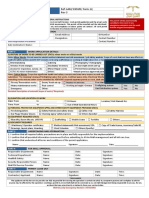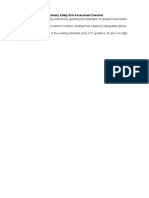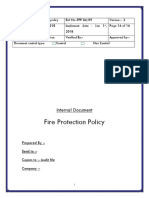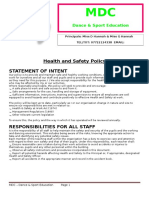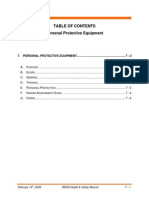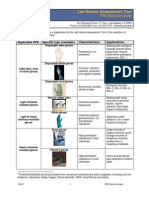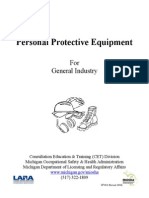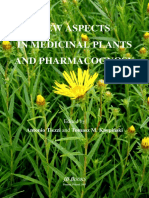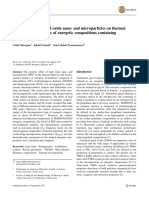Step 2 Who Might Be Harmed and How?: What Are You Already Doing? Step 3: What Further Action Is Necessary?
Step 2 Who Might Be Harmed and How?: What Are You Already Doing? Step 3: What Further Action Is Necessary?
Uploaded by
XozanCopyright:
Available Formats
Step 2 Who Might Be Harmed and How?: What Are You Already Doing? Step 3: What Further Action Is Necessary?
Step 2 Who Might Be Harmed and How?: What Are You Already Doing? Step 3: What Further Action Is Necessary?
Uploaded by
XozanOriginal Description:
Original Title
Copyright
Available Formats
Share this document
Did you find this document useful?
Is this content inappropriate?
Copyright:
Available Formats
Step 2 Who Might Be Harmed and How?: What Are You Already Doing? Step 3: What Further Action Is Necessary?
Step 2 Who Might Be Harmed and How?: What Are You Already Doing? Step 3: What Further Action Is Necessary?
Uploaded by
XozanCopyright:
Available Formats
STFC QUALITATIVE RISK ASSESSMENT
Title : STFC Generic Office Area Risk Assessment (RA) (including office kitchen areas) TO BE EMPLOYED AS A BASIS FOR DEVELOPING RAs FOR LOCAL
OFFICES
Assessed By : TO BE ADDED
Step 1
Step 2
What are the
hazards? It may be
helpful to break the
task or situation
down
Who might be
harmed and how?
Date of Assessment or date last reviewed : TO BE ADDED
What are you already doing?
Step 3:
Step 4:
What further action is necessary?
to reduce risks so far as is
reasonably practicable, one way of
doing this is to compare against
accepted good practice.
How will you put the
Assessment into action? remember to prioritise actions
- high risk hazards first
Action
by who
Slips, trips and
falls
Staff and visitors may
suffer sprains or
fractures if they trip
over trailing
cables/rubbish or slip
on spillages.
1. Housekeeping standards maintained through
Safety Tours and by local management.
2. Cabinet drawers and doors kept closed when
not in use.
3. Trailing cables from electrical machinery
managed, permanent trailing leads fixed and
covered.
4. Floors, windows and doors cleaned on a
regular basis by site operations
5. Repairs and maintenance carried out when
necessary by Site Operations and as reported
by STFC staff.
6. Staff clean up spillages.
Manual handling
All employees and
staff of contract paper
suppliers could suffer
from back pain if they
carry heavy/bulky
objects in awkward
areas for example
printing/photocopying
paper or equipment
1. All staff attend manual handling training as
part of safety induction.
2. Trolleys available to transport boxes of paper
etc.
3. Site Operations teams provide heavy gang
for other heavy loads.
4. Top shelves used for storage of light boxes
only and wherever possible material not
stored above head height.
5. Where materials are stored above head
height, steps/kick stools provided.
Action
by when
Done
STFC QUALITATIVE RISK ASSESSMENT
Title : STFC Generic Office Area Risk Assessment (RA) (including office kitchen areas) TO BE EMPLOYED AS A BASIS FOR DEVELOPING RAs FOR LOCAL
OFFICES
Assessed By : TO BE ADDED
Step 1
Step 2
What are the
hazards? It may be
helpful to break the
task or situation
down
Who might be
harmed and how?
Date of Assessment or date last reviewed : TO BE ADDED
What are you already doing?
Step 3:
Step 4:
What further action is necessary?
to reduce risks so far as is
reasonably practicable, one way of
doing this is to compare against
accepted good practice.
How will you put the
Assessment into action? remember to prioritise actions
- high risk hazards first
Action
by who
1. All shelving to be installed by competent staff
on load bearing structures.
2. Shelf loading and state of office furniture an
issue addressed by safety tours.
3. Filling cabinets have one draw open at time
labels or are restricted.
4. Heavy/bulky items should not be stored at
height in offices.
Falling materials,
toppling furniture
Staff in offices may
suffer injury from
material falling from
overloaded or
collapsing shelves or
items stored at
height.
Regular computer
use
All employees could
suffer from upper
limb disorders, eye
strain, headaches
from regular use of
PCs
1. Adjustable equipment, chair and footrest,
monitor and keyboard available to all staff.
2. Free eye test provided to all those working
regularly with PCs and suspect eye related
issues by arrangement through local
Occupation Health teams.
3. Blinds provided to control ambient lighting.
4. All employees attend DSE training as part of
their SHE induction and a DSE assessment
available through DSE local assessors.
Stress
Employees could be
affected by excessive
pressure at work from
e.g. work demands,
lack of job control,
poor support from
1. STFC Stress Policy in place.
2. Work plans and work objectives are discussed
and agreed with staff annually through APR.
3. Provision of Occupational Health services at
major laboratories includes provision of
Action
by when
Done
STFC QUALITATIVE RISK ASSESSMENT
Title : STFC Generic Office Area Risk Assessment (RA) (including office kitchen areas) TO BE EMPLOYED AS A BASIS FOR DEVELOPING RAs FOR LOCAL
OFFICES
Assessed By : TO BE ADDED
Step 1
Step 2
What are the
hazards? It may be
helpful to break the
task or situation
down
Who might be
harmed and how?
Date of Assessment or date last reviewed : TO BE ADDED
What are you already doing?
Step 3:
Step 4:
What further action is necessary?
to reduce risks so far as is
reasonably practicable, one way of
doing this is to compare against
accepted good practice.
How will you put the
Assessment into action? remember to prioritise actions
- high risk hazards first
Action
by who
colleagues or
manager, poor role
clarity, poor
relationships, or
badly managed
change.
counselling services.
Electrical
All staff could incur
electrical shocks or
burns if they use
faulty electrical
equipment.
1. Sufficient sockets provided in offices, daisy
chaining of extension leads not permitted.
2. Staff report defective plugs, cabling, electrical
equipment to manager.
3. Photocopiers maintained on contract.
4. All equipment brought onto STFC sites PAT
tested before use and all existing electrical
equipment subjected to annual or 4 yearly
PAT tests, see PAT code.
5. Only authorised staff permitted to work on
electrical equipment.
Fire
If trapped in the office
all staff and visitors
could suffer from
smoke inhalation or
burns.
1. Fire evacuation procedures displayed at each
call point.
2. Fire drills tested annually.
3. Exits and fire exits clearly marked.
4. Access to exits and extinguishers to be kept
clear at all times.
5. Fire alarms maintained and tested by
Action
by when
Done
STFC QUALITATIVE RISK ASSESSMENT
Title : STFC Generic Office Area Risk Assessment (RA) (including office kitchen areas) TO BE EMPLOYED AS A BASIS FOR DEVELOPING RAs FOR LOCAL
OFFICES
Assessed By : TO BE ADDED
Step 1
Step 2
What are the
hazards? It may be
helpful to break the
task or situation
down
Who might be
harmed and how?
Date of Assessment or date last reviewed : TO BE ADDED
What are you already doing?
Step 3:
Step 4:
What further action is necessary?
to reduce risks so far as is
reasonably practicable, one way of
doing this is to compare against
accepted good practice.
How will you put the
Assessment into action? remember to prioritise actions
- high risk hazards first
Action
by who
competent persons.
6. Custom and good practise is that office
windows and doors are closed at the end of
the working day.
7. Waste bins emptied regularly by cleaners.
8. Storage of combustible materials, paper,
minimised and raised during safety tours.
Chemical burns
including bleach
and strong
detergents
Direct skin contact
with could lead to the
cleaner getting skin
irritation.
Chemical vapours
may cause eye
irritation or breathing
difficulties.
Aerosols may present
environmental and
fire hazards.
1. Storage of chemicals is not permitted in
offices or kitchen areas.
2. Cleaning services provided by competent
contracting companies responsible for the
training and competence of their staff. STFC
staff should not come into contact with office
cleaning materials.
3. Pressurized aerosol cans should not be
employed and, where possible, water based
products used as alternatives to solvents as
found in wipe board and other cleaning
products or correction fluids.
Action
by when
Done
STFC QUALITATIVE RISK ASSESSMENT
Title : STFC Generic Office Area Risk Assessment (RA) (including office kitchen areas) TO BE EMPLOYED AS A BASIS FOR DEVELOPING RAs FOR LOCAL
OFFICES
Assessed By : TO BE ADDED
Step 1
Step 2
What are the
hazards? It may be
helpful to break the
task or situation
down
Who might be
harmed and how?
Date of Assessment or date last reviewed : TO BE ADDED
What are you already doing?
Step 3:
Step 4:
What further action is necessary?
to reduce risks so far as is
reasonably practicable, one way of
doing this is to compare against
accepted good practice.
How will you put the
Assessment into action? remember to prioritise actions
- high risk hazards first
Action
by who
Burns
Staff preparing hot
food, utilising kitchen
equipment e.g. kettle,
cooker and
microwave.
1. Kettles, cookers and microwaves are
examples of domestic equipment for which
staff need no specific training. The equipment
should be used as directed in instruction
manuals.
Smoking
Passive smoking can
damage the health of
all staff.
2. No Smoking policy adopted in STFC
buildings. Smokers must smoke outside
building, at least 5m from periphery of
building, specifically entrances or exits.
Hygiene and
welfare
All staff could
experience general
discomfort.
1. Toilets supplied with hot and cold water, soap
and drying facilities.
2. Wash-up/kitchen areas provided with drinking
water and as appropriate fridge and
microwave, cleaned on office cleaning
schedule.
Environmental
comfort factors.
All staff may feel too
hot/cold or suffer
other general
discomfort.
1. Buildings kept reasonably warm and light with
opening windows to provide fresh air, plenty
of space in offices.
Photocopiers
Staff using
photocopiers could
be exposed to UV
radiation and ozone.
1. Staff employ photocopiers as directed in
instruction manuals.
2. Photocopiers not located in small offices with
poor ventilation.
Action
by when
Done
STFC QUALITATIVE RISK ASSESSMENT
Title : STFC Generic Office Area Risk Assessment (RA) (including office kitchen areas) TO BE EMPLOYED AS A BASIS FOR DEVELOPING RAs FOR LOCAL
OFFICES
Assessed By : TO BE ADDED
Step 1
Step 2
What are the
hazards? It may be
helpful to break the
task or situation
down
Who might be
harmed and how?
Date of Assessment or date last reviewed : TO BE ADDED
What are you already doing?
Step 3:
Step 4:
What further action is necessary?
to reduce risks so far as is
reasonably practicable, one way of
doing this is to compare against
accepted good practice.
How will you put the
Assessment into action? remember to prioritise actions
- high risk hazards first
Action
by who
Step 5 Review
Date:
Action
by when
Review your assessment to make sure you are still improving, or at least not sliding back.
If there is a significant change in your workplace, remember to check your risk assessment and where necessary, amend it.
Review your assessment by default at least 2 yearly
Done
You might also like
- Jsa Setting Crane and Lifting GeneratorDocument2 pagesJsa Setting Crane and Lifting GeneratorSeppy Fajriani100% (1)
- Plant Pre Start ProcedureDocument1 pagePlant Pre Start Procedureheppy prastyo nugroho0% (1)
- Project ProposalDocument17 pagesProject Proposalabebe belahNo ratings yet
- Project: Field Erection of 15000 Bbls Tank (Ik-2545) : Job Safety Analysis / Safe Work Method Statement-SWMSDocument2 pagesProject: Field Erection of 15000 Bbls Tank (Ik-2545) : Job Safety Analysis / Safe Work Method Statement-SWMSJohn100% (1)
- Feasibility of Using Sea Shells Ash As Admixtures For ConcreteDocument7 pagesFeasibility of Using Sea Shells Ash As Admixtures For ConcreteGururaj Sivaprakasam100% (1)
- Neproplast Upvc PipesDocument36 pagesNeproplast Upvc PipesperezismaelNo ratings yet
- I Safe TrainingDocument61 pagesI Safe TrainingiddsubraNo ratings yet
- SDS - Fenomastic Enamel Semigloss - English (Uk) - DubaiDocument5 pagesSDS - Fenomastic Enamel Semigloss - English (Uk) - DubaiBalasubramanian AnanthNo ratings yet
- Hse Award Categories DetailsDocument7 pagesHse Award Categories DetailsnmamNo ratings yet
- Risk Assessments For FormworkDocument1 pageRisk Assessments For FormworkQays YousefNo ratings yet
- FAHU Risk AssessmentDocument2 pagesFAHU Risk AssessmentRaqib NawazNo ratings yet
- Gas Cutting Risk AssessmentDocument3 pagesGas Cutting Risk Assessmentchemjesu100% (1)
- Hira For Pipe Coating Monsher Fire Protectioin System P. L.Document31 pagesHira For Pipe Coating Monsher Fire Protectioin System P. L.Nikhil ManjrekarNo ratings yet
- Site Environmental Control ReportDocument5 pagesSite Environmental Control ReportJasonTeeNo ratings yet
- JSO Cable Drum (02 Sept.'07)Document2 pagesJSO Cable Drum (02 Sept.'07)Francis Enriquez TanNo ratings yet
- Blasting and Painting - BUHPDocument6 pagesBlasting and Painting - BUHPMuhammed yahiyaNo ratings yet
- Mobilization Risk AssessmentDocument53 pagesMobilization Risk AssessmentRAMY ABOU AL DAHABNo ratings yet
- Risk Assesment FOR TERMITE TREATMENTDocument1 pageRisk Assesment FOR TERMITE TREATMENTindunilNo ratings yet
- Tata Bluescope Steel Limited, Jamshedpur.: Liquefied Petroleum Gas Material Safety Data SheetDocument6 pagesTata Bluescope Steel Limited, Jamshedpur.: Liquefied Petroleum Gas Material Safety Data Sheetsujit5584No ratings yet
- Risk Assessment - Hot Water BoilersDocument4 pagesRisk Assessment - Hot Water BoilersUgonnaNo ratings yet
- RD Mine Hira (Vehicle and Driving) Location Risk Identification Control Measure Implementation Verification of Control MeasureDocument3 pagesRD Mine Hira (Vehicle and Driving) Location Risk Identification Control Measure Implementation Verification of Control Measureananthu.u100% (1)
- Register For Fire Extinguisher (Done)Document2 pagesRegister For Fire Extinguisher (Done)ghifariaghniaNo ratings yet
- RB - HSE Daily Observation Report Dated 06.11.2021Document5 pagesRB - HSE Daily Observation Report Dated 06.11.2021Idris AdeniranNo ratings yet
- Al Ain Mall-Permit To Work Application: Ref: AAM/ EHSMS/ Form-12, Rev-3 Permit No (For Office Use Only)Document1 pageAl Ain Mall-Permit To Work Application: Ref: AAM/ EHSMS/ Form-12, Rev-3 Permit No (For Office Use Only)Veterano 1968No ratings yet
- Standard Operating Procedure For Hot Works Operations: PurposeDocument3 pagesStandard Operating Procedure For Hot Works Operations: PurposeShital 2No ratings yet
- Rules For Electric SafetyDocument1 pageRules For Electric SafetyEmoji SquadNo ratings yet
- Pera JackhammerDocument7 pagesPera Jackhammerjumansyahamid1988No ratings yet
- Fire Extinguisher Inspection TagDocument2 pagesFire Extinguisher Inspection Tagshubham dabasNo ratings yet
- JSA ScaffoldingDocument2 pagesJSA Scaffoldingmyco samNo ratings yet
- 326-Project Training Plan Rev 000Document1 page326-Project Training Plan Rev 000francisNo ratings yet
- SWP-20 Usage of Ladder DaimanDocument1 pageSWP-20 Usage of Ladder DaimanHassan AbdullahNo ratings yet
- Weighbridge 100 Ton Erectionoperation and Maintenance JSA HSE ProfessionalsDocument2 pagesWeighbridge 100 Ton Erectionoperation and Maintenance JSA HSE ProfessionalsAli KaziNo ratings yet
- Circular Saw Inspection ChecklistDocument1 pageCircular Saw Inspection ChecklistIdada EzekielNo ratings yet
- Checklist For Scaffolding 2Document2 pagesChecklist For Scaffolding 2Aejaz Mujawar100% (1)
- Risk Assessment SML Plate CompactorDocument4 pagesRisk Assessment SML Plate CompactorAhmed IdreesNo ratings yet
- JSO Slip, Trips & Fall (27 Aug.'07)Document1 pageJSO Slip, Trips & Fall (27 Aug.'07)Francis Enriquez TanNo ratings yet
- Shovel ChecklistDocument2 pagesShovel Checklistjamal motaNo ratings yet
- Jha RWFW Raft Cocrete JobDocument3 pagesJha RWFW Raft Cocrete JobsoubhagyaNo ratings yet
- Sample Igc3 ReportDocument25 pagesSample Igc3 Reportfarhanhussain852100% (2)
- Manual Handling (Risk Assessment)Document3 pagesManual Handling (Risk Assessment)khurram shahzadNo ratings yet
- Checklist For Equipment Inspection BikeDocument1 pageChecklist For Equipment Inspection BikeHung Hoang0% (1)
- Welding, Cutting, and Brazing: Self-Inspection ChecklistDocument2 pagesWelding, Cutting, and Brazing: Self-Inspection ChecklistArmin Patel100% (1)
- A-2.2-21-17-01 - Bentonite MixerDocument1 pageA-2.2-21-17-01 - Bentonite MixerNisanth ThulasidasNo ratings yet
- Lock Out Tag Out Machinery Safety Risk Assessment ChecklistDocument13 pagesLock Out Tag Out Machinery Safety Risk Assessment ChecklistAshish MishraNo ratings yet
- Lessons Learnt - Trench CollapseDocument2 pagesLessons Learnt - Trench CollapseEhab SaadNo ratings yet
- Application To Perform Work - Grass CuttingDocument2 pagesApplication To Perform Work - Grass CuttingRauf Huseynov0% (1)
- Guidelines For Fire Drill and Evacuation Procedures For High Rise BuildingsDocument9 pagesGuidelines For Fire Drill and Evacuation Procedures For High Rise BuildingsTrinath Dash MohiniNo ratings yet
- Plastering Risk AssessmentDocument22 pagesPlastering Risk AssessmentAhmed IbrahimNo ratings yet
- BVI-HSE Daily Report 20220629Document3 pagesBVI-HSE Daily Report 20220629Muhammad IrfanNo ratings yet
- Fire Protection PolicyDocument4 pagesFire Protection PolicyWalid El WahshNo ratings yet
- Hazard and Risk RegistersDocument18 pagesHazard and Risk RegistersWole OyefisayoNo ratings yet
- Scaffold CampaignDocument9 pagesScaffold CampaignAdel SukerNo ratings yet
- Emergency PlanDocument8 pagesEmergency PlanMohamed Eltaweel100% (1)
- Health and Safety FileDocument3 pagesHealth and Safety Fileaaktgt MepNo ratings yet
- 011 Duct Lifter SWMSDocument2 pages011 Duct Lifter SWMSJ Johnson100% (1)
- Mdc-Policies-Health SafetyDocument3 pagesMdc-Policies-Health Safetyapi-325880402No ratings yet
- Hazard Identification Plan (Hip) For Adgosp-2: Upgrade Fire Protection System, Phase Ii at Saoo Gosps Project No.Document27 pagesHazard Identification Plan (Hip) For Adgosp-2: Upgrade Fire Protection System, Phase Ii at Saoo Gosps Project No.HaleemUrRashidBangashNo ratings yet
- M013-JAC-HSE-RPT-00146 Close Out 04.10.2018Document10 pagesM013-JAC-HSE-RPT-00146 Close Out 04.10.2018Anonymous 3WKsDwPNo ratings yet
- Blasting Work PermitDocument2 pagesBlasting Work PermitHariharan MuthukrishananNo ratings yet
- The Handbook of Safety Engineering: Principles and ApplicationsFrom EverandThe Handbook of Safety Engineering: Principles and ApplicationsRating: 4 out of 5 stars4/5 (1)
- Risk Assessment FormDocument2 pagesRisk Assessment FormYu JunanNo ratings yet
- NEBOSHDocument22 pagesNEBOSHJafar Khan100% (6)
- Personal Protective EquipmentDocument10 pagesPersonal Protective EquipmentXozanNo ratings yet
- FIEF Recommended FA Kit Contents 162295Document2 pagesFIEF Recommended FA Kit Contents 162295XozanNo ratings yet
- Electrical Safety AuditDocument19 pagesElectrical Safety AuditXozan100% (3)
- Siemens XDocument13 pagesSiemens XXozanNo ratings yet
- Title Carry Out In-Service Visual Inspections On Substation Equipment For Safe Operation Level 3 Credits 4Document5 pagesTitle Carry Out In-Service Visual Inspections On Substation Equipment For Safe Operation Level 3 Credits 4XozanNo ratings yet
- Project NavigatorDocument9 pagesProject NavigatorXozanNo ratings yet
- Lab Hazard Assessment Tool: Applicable PPE Specific Type (Example) Characteristics ApplicationsDocument4 pagesLab Hazard Assessment Tool: Applicable PPE Specific Type (Example) Characteristics ApplicationsXozanNo ratings yet
- 2011 Dam Inspection ChecklistDocument2 pages2011 Dam Inspection ChecklistXozanNo ratings yet
- OHS Plan 2012 University WideDocument3 pagesOHS Plan 2012 University WideXozanNo ratings yet
- Personal Protective Equipment: For General IndustryDocument28 pagesPersonal Protective Equipment: For General IndustryXozanNo ratings yet
- Cyclic Events Checklist: 1. Faculty/Graduate School/DivisionDocument3 pagesCyclic Events Checklist: 1. Faculty/Graduate School/DivisionXozanNo ratings yet
- Cyclic Events Checklist: 1. Faculty/Graduate School/DivisionDocument2 pagesCyclic Events Checklist: 1. Faculty/Graduate School/DivisionXozanNo ratings yet
- Deficiency Checklist: Is There Any Apparent... YES NO If Yes Then..Document1 pageDeficiency Checklist: Is There Any Apparent... YES NO If Yes Then..XozanNo ratings yet
- Chemical Risk Assessment Worksheet: Printer Toner - MagentaDocument3 pagesChemical Risk Assessment Worksheet: Printer Toner - MagentaXozanNo ratings yet
- Cyclic Events Biological Laboratory TemplateDocument3 pagesCyclic Events Biological Laboratory TemplateXozanNo ratings yet
- Working of Blast FurnaceDocument3 pagesWorking of Blast Furnacehk168No ratings yet
- Mnso 4Document5 pagesMnso 4Muhammad AndrianNo ratings yet
- Part XI - CHEMISTRY OF CARBON COMPOUNDS (Part 1)Document67 pagesPart XI - CHEMISTRY OF CARBON COMPOUNDS (Part 1)yana LAUNo ratings yet
- Determination of PH of Common Solutions Using PH Paper and PH MeterDocument2 pagesDetermination of PH of Common Solutions Using PH Paper and PH MeterKeziah Casco CortadoNo ratings yet
- Lecture IntroductionDocument9 pagesLecture IntroductionTejasv RajputNo ratings yet
- SB 100 Eriez Plate MagnetDocument8 pagesSB 100 Eriez Plate MagnetSuyapa Lainez LainezNo ratings yet
- TM 9 2320 363 20 2Document1,266 pagesTM 9 2320 363 20 2AdvocateNo ratings yet
- Is 542 1968 PDFDocument18 pagesIs 542 1968 PDFSriram SubramanianNo ratings yet
- 4 10 1 SMDocument167 pages4 10 1 SMD1 PharmacistNo ratings yet
- Brochure SouthpartnersDocument19 pagesBrochure SouthpartnersStanislau Felix Garcia RomeroNo ratings yet
- 2a. Jee Main Mock Test 2 - QPDocument24 pages2a. Jee Main Mock Test 2 - QPSubrata KarmakarNo ratings yet
- Boiler Water TreatmentDocument30 pagesBoiler Water TreatmentDeo Anugrah Utomo100% (6)
- Nuclear Fission and Fusion Project PDFDocument54 pagesNuclear Fission and Fusion Project PDFHarsh BislaNo ratings yet
- Experimental Studies On Glass Fiber ConcreteDocument5 pagesExperimental Studies On Glass Fiber ConcreteChaitanya KumarNo ratings yet
- SSC Je BMC: Poll Quiz Daily 4:00PMDocument38 pagesSSC Je BMC: Poll Quiz Daily 4:00PMNishikanta MondalNo ratings yet
- Catalytic Effect of Lead Oxide Nano-And Microparticles On Thermal Decomposition Kinetics of Energetic Compositions Containing Tegdn/Nc/DagDocument12 pagesCatalytic Effect of Lead Oxide Nano-And Microparticles On Thermal Decomposition Kinetics of Energetic Compositions Containing Tegdn/Nc/DagSabri AeroChemNo ratings yet
- Rhodia Pharma Flyers 2 enDocument8 pagesRhodia Pharma Flyers 2 enTueNo ratings yet
- Mineral-Insulated Thermocouples According To DIN 43710 and DIN EN 60584Document11 pagesMineral-Insulated Thermocouples According To DIN 43710 and DIN EN 60584Veryco BudiantoNo ratings yet
- Chemistry: Pearson EdexcelDocument28 pagesChemistry: Pearson EdexcelAhmad MohdNo ratings yet
- The Philippines in The Chemical Global Value ChainDocument78 pagesThe Philippines in The Chemical Global Value ChainAlna DifieNo ratings yet
- Floor Calculation - November 7th 2016Document8 pagesFloor Calculation - November 7th 2016Seid HodzicNo ratings yet
- Alloys Poured at Tech Cast PDFDocument7 pagesAlloys Poured at Tech Cast PDFTomy NoviadiNo ratings yet
- ASTM D4752 MEK Test PDFDocument8 pagesASTM D4752 MEK Test PDFNgô Trung NghĩaNo ratings yet
- Polymer ConcreteDocument15 pagesPolymer ConcreteHew LockNo ratings yet
- Chemical and Technological Studies of Mango Seed KernelDocument9 pagesChemical and Technological Studies of Mango Seed KernelJumbo BasseyNo ratings yet
- Adsorption Isotherms For The System Pentane-Hexane-IsooctaneDocument4 pagesAdsorption Isotherms For The System Pentane-Hexane-IsooctaneJuan Manuel Mesa SernaNo ratings yet
- Chemical Industry DatabaseDocument24 pagesChemical Industry Databaseanon_981731217No ratings yet
























